Why you can trust Tom's Hardware
Our graphics card test PC uses an Nvidia PCAT v2 device, which combined with FrameView allows us to capture power, temperature, and GPU clocks from our full gaming suite — along with the usual frame times. The charts below show the geometric mean across all 15 games, though we also have full tables showing the individual results further down the page.
We have separate charts for 1080p medium/ultra, 1440p ultra, and 4K ultra in the galleries below. Keep in mind that factory overclocked cards will also perform differently, so the data here is for the reference RTX 4080 Super Founders Edition. Reference clocked cards will likely have similar power and clock characteristics, though cooling, VRMs, and other elements can affect the results.
Nvidia RTX 4080 Super Power Use
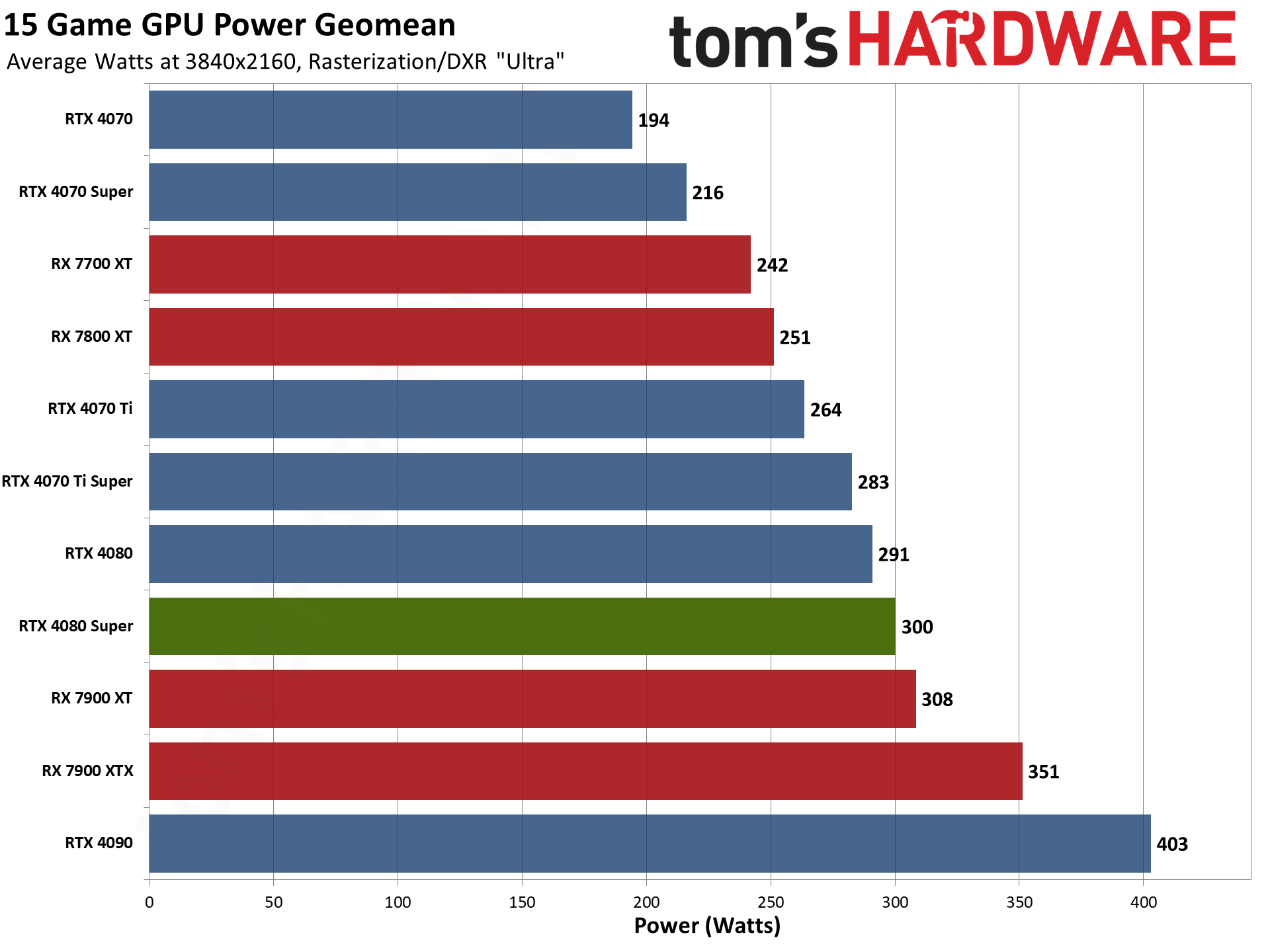



The RTX 4080 Super puts Nvidia's Ada Lovelace architecture to good use, delivering excellent performance and efficiency characteristics yet again. Compared to the RTX 4080, it has the same nominal 320W TGP, and across our full test suite, it averaged 216W at 1080p medium, 248W at 1080p ultra, 276W at 1440p ultra, and 300W at 4K ultra. There are plenty of games where it's not drawing the full 320W, in other words.
In terms of performance per watt, it's nearly identical to the RTX 4080, which was already the most efficient GPU we've tested. The 4080 Super is also 33% more efficient than AMD's 7900 XTX at 4K, and up to 58% more efficient at 1080p. That's part of the price AMD paid by going with GPU chiplets, which are inherently less efficient at moving data compared to monolithic designs.
That's not to say there aren't games where the 4080 Super can draw its full 320W. We measured power use ranging between 212–323 watts at 1440p and 4K, with the highest power draw generally coming in ray tracing games. Of course, DLSS upscaling and frame generation should reduce power use compared to native rendering.
Nvidia RTX 4080 Super Clock Speeds

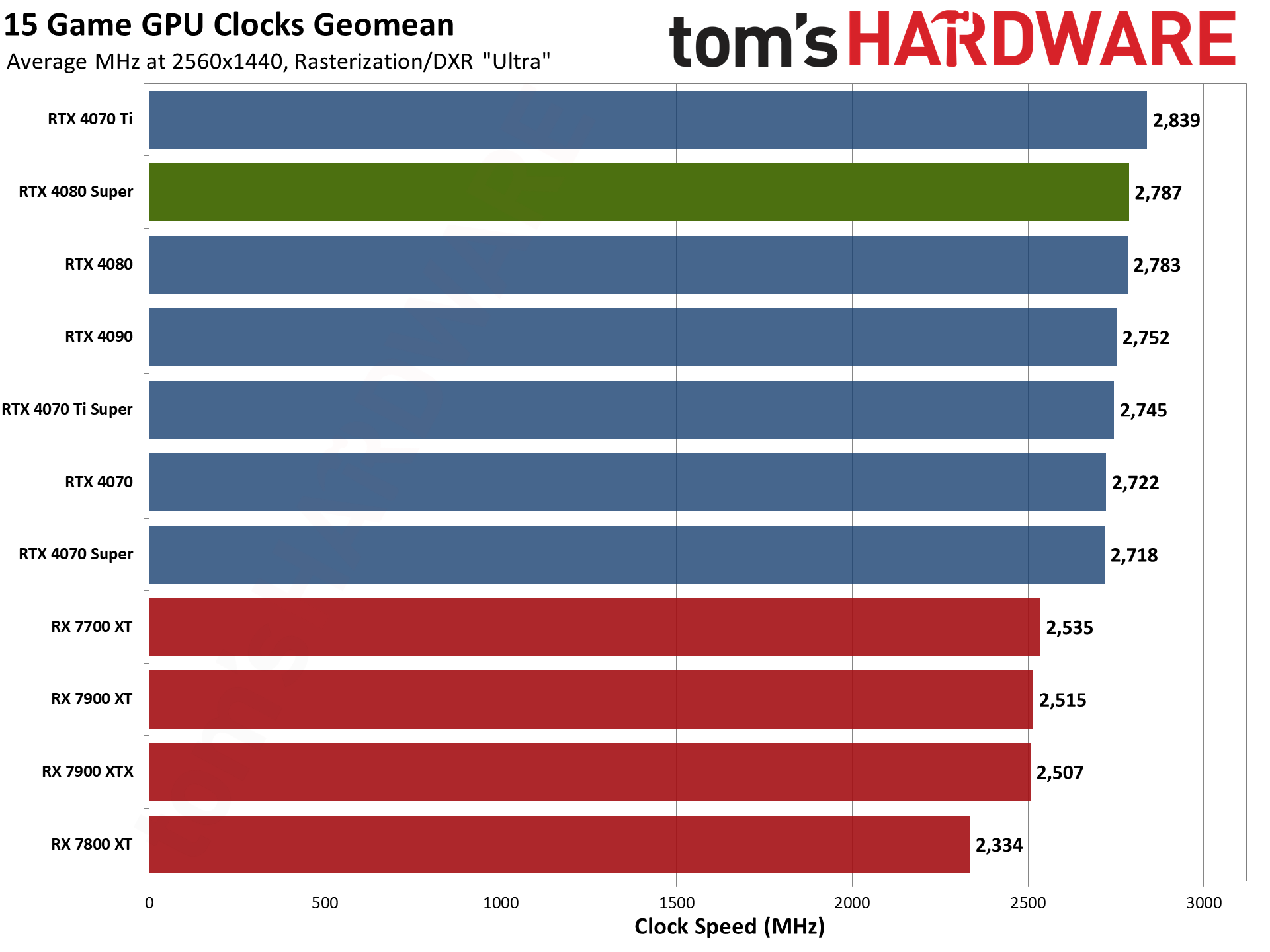
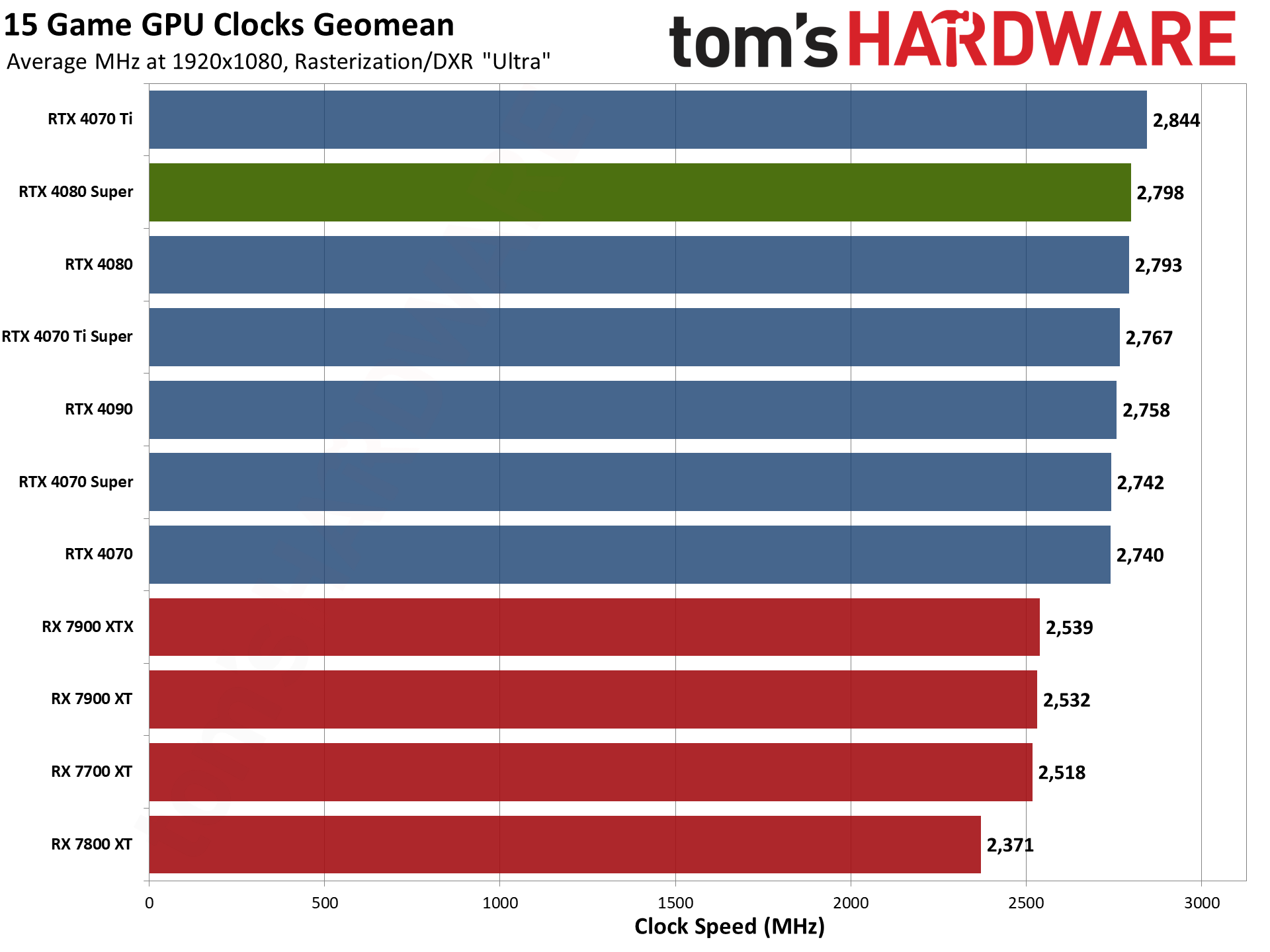
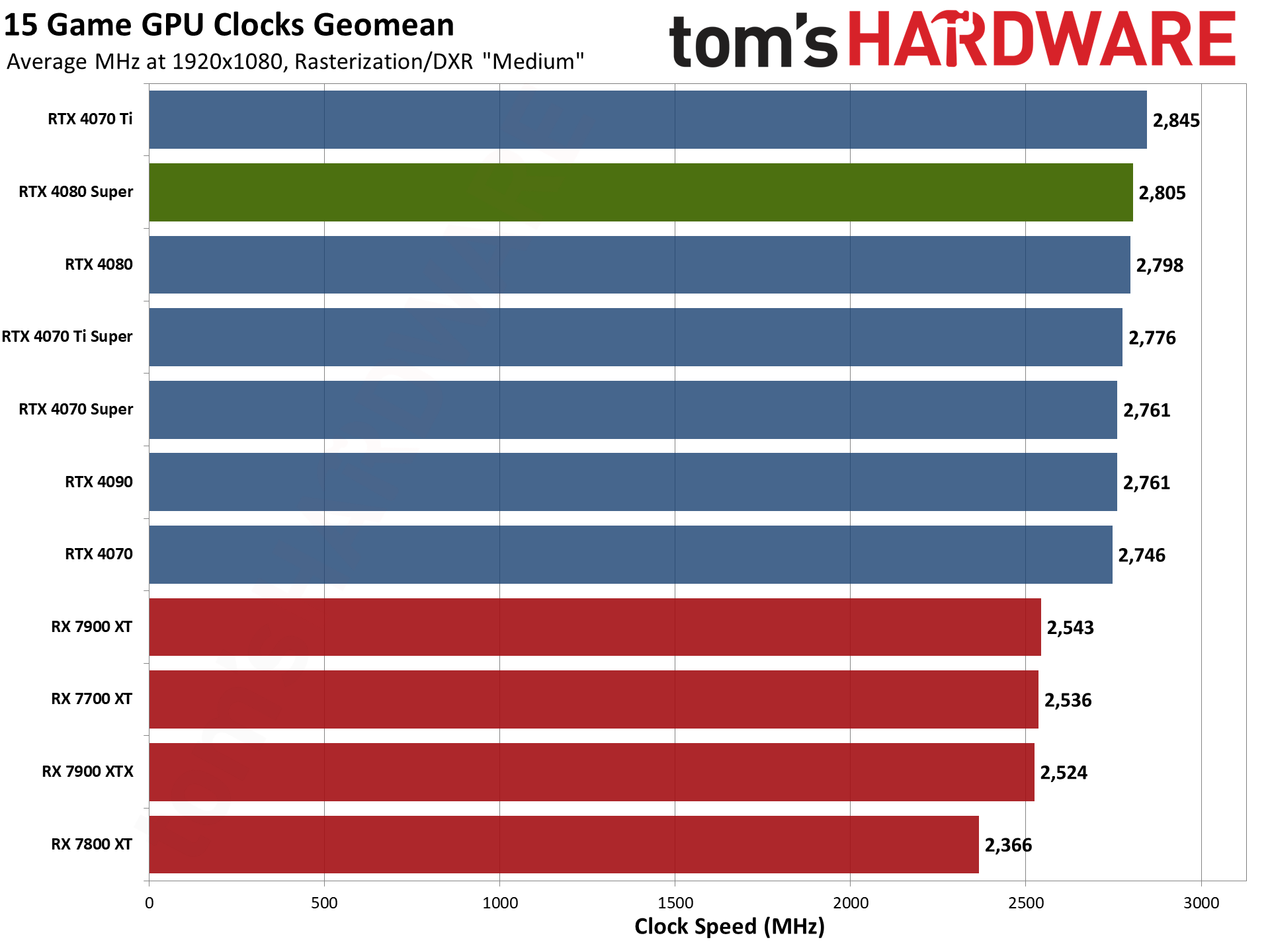
Nvidia's official boost clocks with the Ada Lovelace series have been very conservative, by around 150–200 MHz typically. That's basically the case with the RTX 4080 Super as well. The rated boost clock is 2550 MHz, and across our test suite we saw average GPU clocks of around 2800 MHz at 1080p, 2790 MHz at 1440p, and 2770 MHz at 4K. Those aren't quite the highest clock speeds we've seen out of a reference card — the 4070 Ti averaged more than 2.8 GHz across all resolutions — but it's pretty close.
Factory overclocked cards will very likely exceed 2.8 GHz, and perhaps even 2.9 GHz in some games. The highest clocks we saw in our testing for a single game were 2.82 GHz, in quite a few of the games, and that appears to be close to the limit for the 4080 Super Founders Edition (without manual overclocking, at least).
Nvidia RTX 4080 Super Temperatures

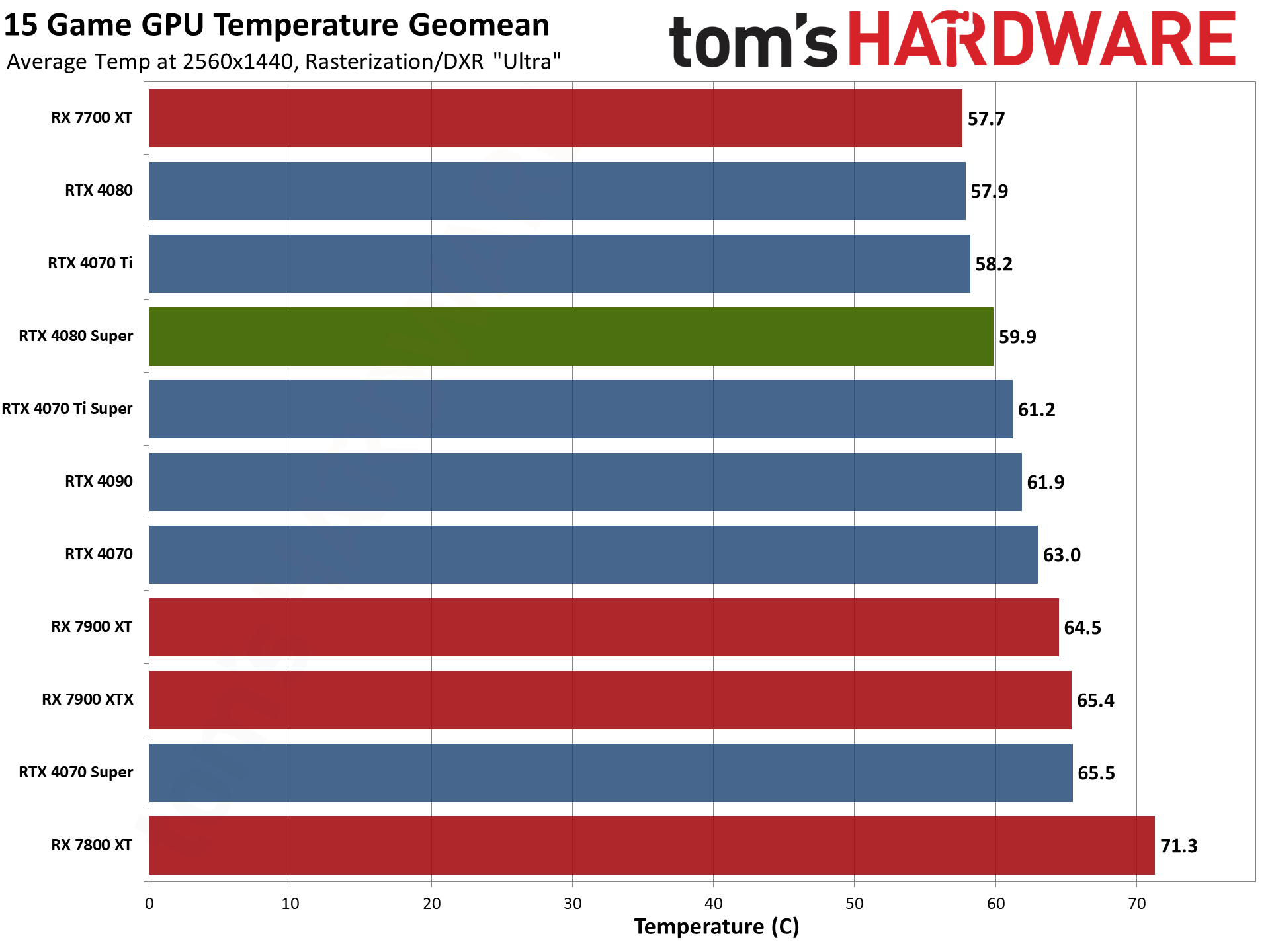
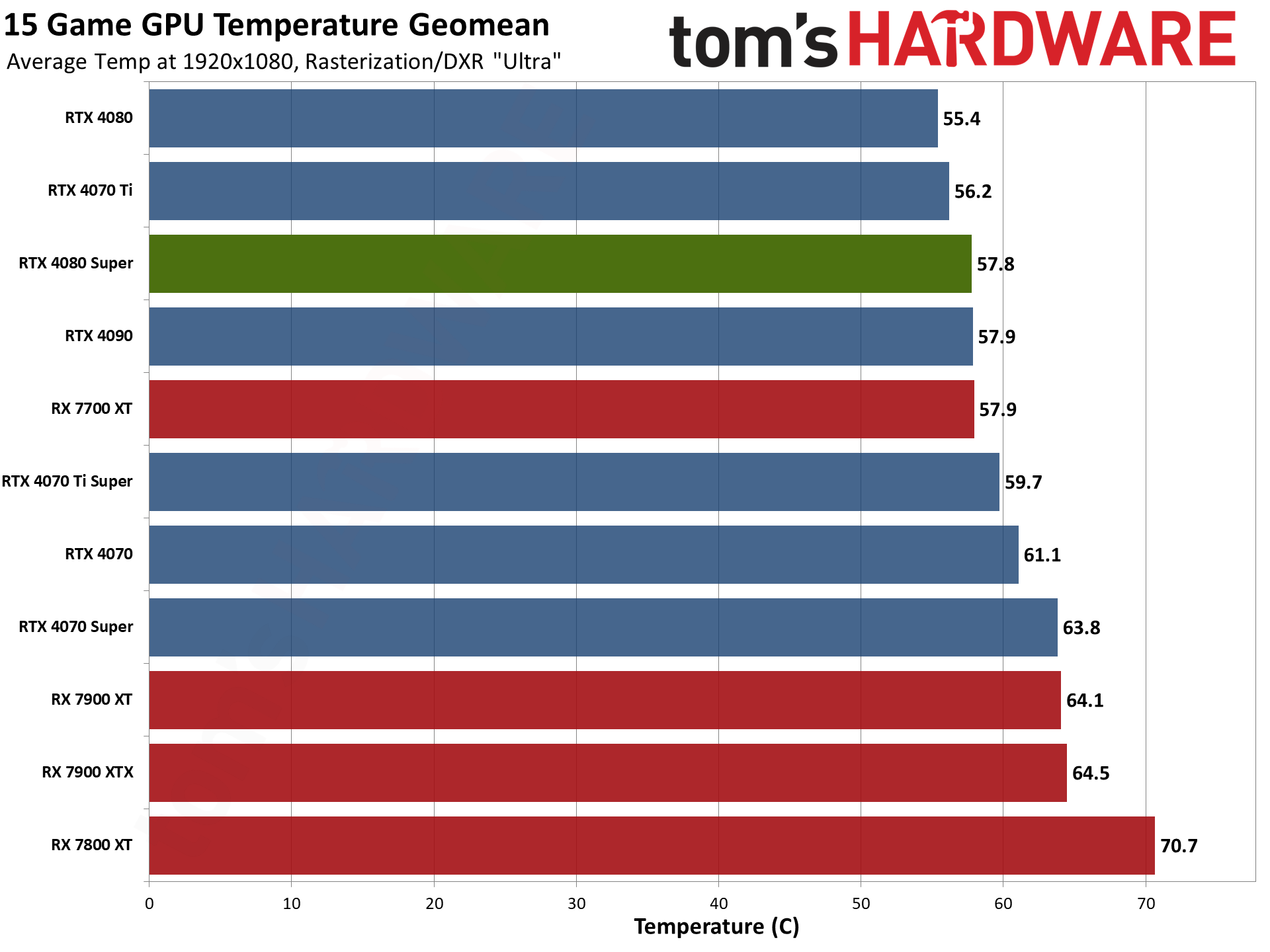
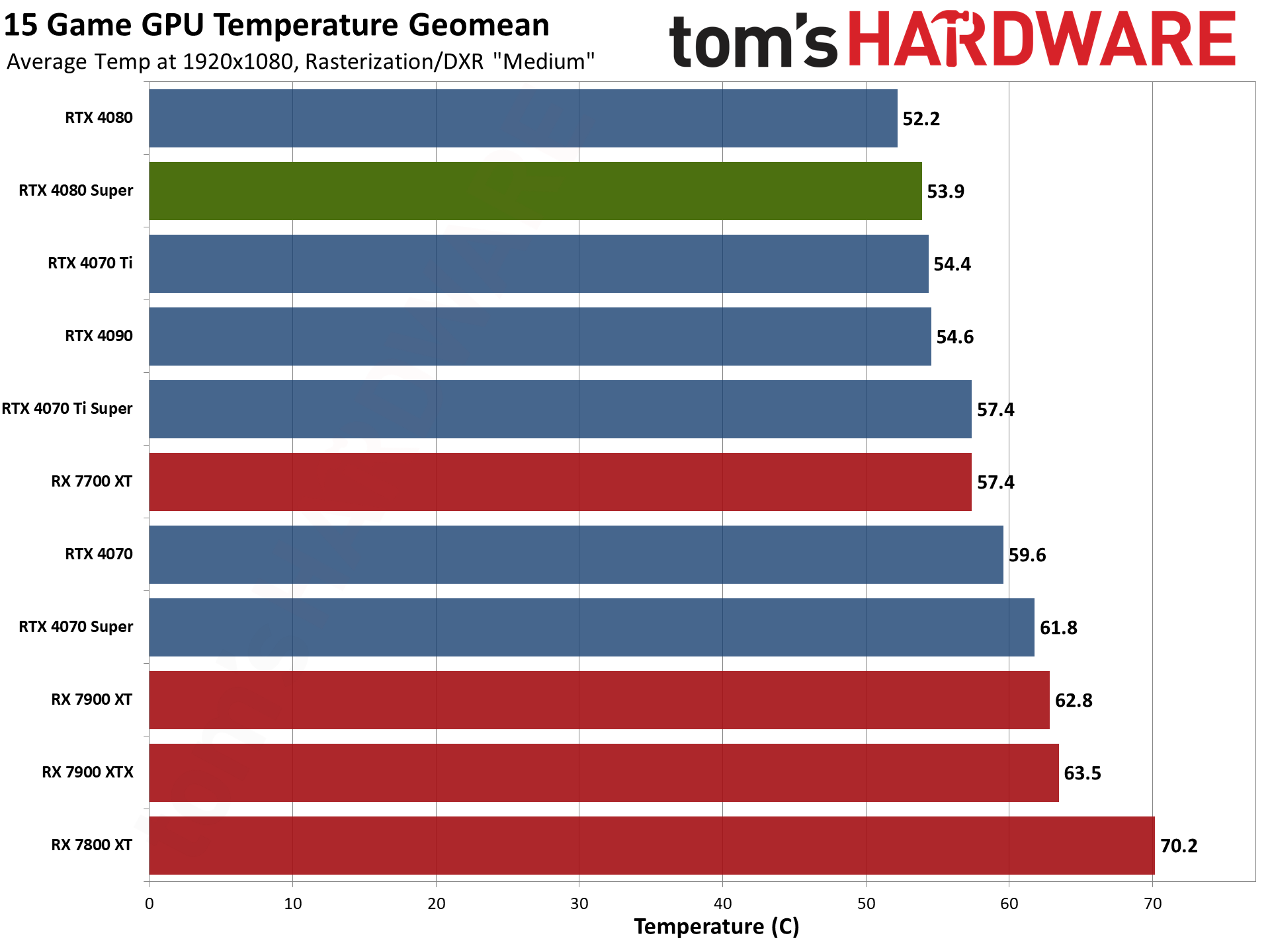
GPU temperatures depend very much on firmware tuning and fan speeds, as well as the heatsink and fans. Considering the 4080 Super Founders Edition basically has the same cooling setup as the 4090 Founders Edition, it should have no difficulty maintaining decent temperatures.
Average temperatures for the 4080 Super Founders Edition were very good, sitting at 62C at 4K, 60C at 1440p, 58C at 1080p ultra, and just 54C at 1080p medium. That goes hand in hand with the power use measured above, with the fans ramping up to higher RPMs for more demanding settings.
The highest temperatures we saw throughout our tests suite were 66–67 degrees Celsius, with Metro Exodus Enhanced Edition being the worst-case result. Several of the games didn't even break 60C, but as we so often note, temperatures are only part of the story, with fan speeds (and noise) being the other key ingredient.
Nvidia RTX 4080 Super Noise Levels


With the same TGP and cooler as the RTX 4080 Founders Edition, and slightly higher temperatures, we expected noise levels to be relatively similar between the vanilla 4080 and the 4080 Super. Once temperatures and fan speeds stabilized, noise from the 4080 Super was 43.9 dB(A), about one decibel louder than the 4080. Fan speed at that point was 41% — a touch faster than the 38% we saw back when we first tested the 4080 Founders Edition.
We also test with a static fan speed of 75%, which resulted in 56.3 dB(A), which was about one decibel quieter than the 4080 at that same fan speed. Even under heavier loads, we never heard the fans reach anything close to that noise level, and there's plenty of headroom for overclocking if you wan to tweak your card settings a bit.
As always, note that our testing of the reference cards used here does not represent other 4080 Super models. We'll have some third-party card reviews in the coming week or two, and we'll see how those compare to Nvidia's Founders Edition. We suspect most won't beat the reference design, which is overbuilt for the 4080 Super, but we'll have to see how that goes once we test the other cards.
Our noise test consists of running Metro Exodus, because it's one of the more power hungry games. We load a save, with graphics set to appropriately strenuous levels (4K ultra in this case), and then let the game sit for at least 15 minutes before checking noise levels. We place the SPL (sound pressure level) meter 10cm from the card, with the mic aimed at the center of the 'front' fan on the 4080 Super Founders Edition. This helps minimize the impact of other noise sources, like the fans on the CPU cooler. The noise floor of our test environment and equipment is 31–32 dB(A).
Full Gaming Test Results

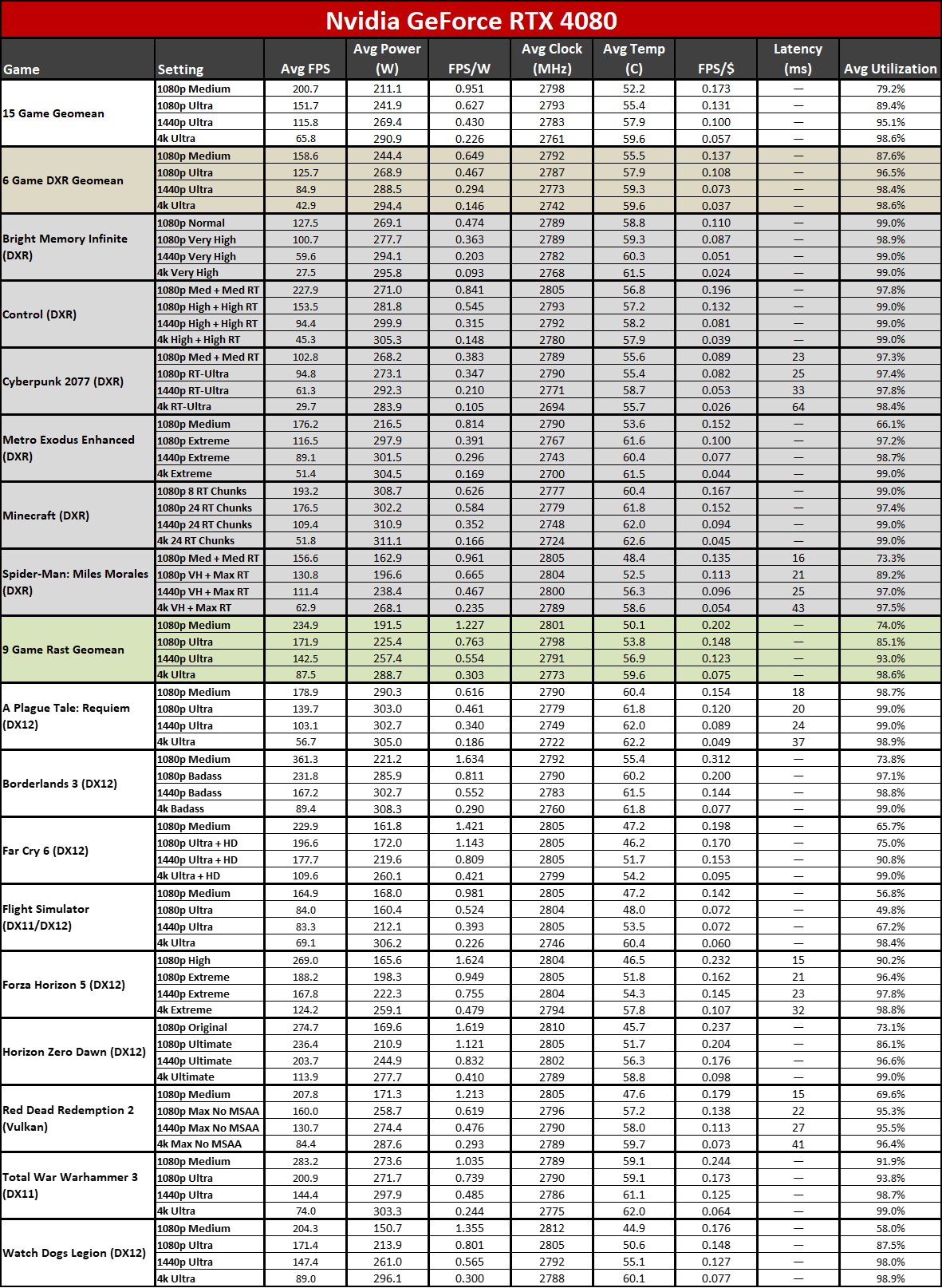
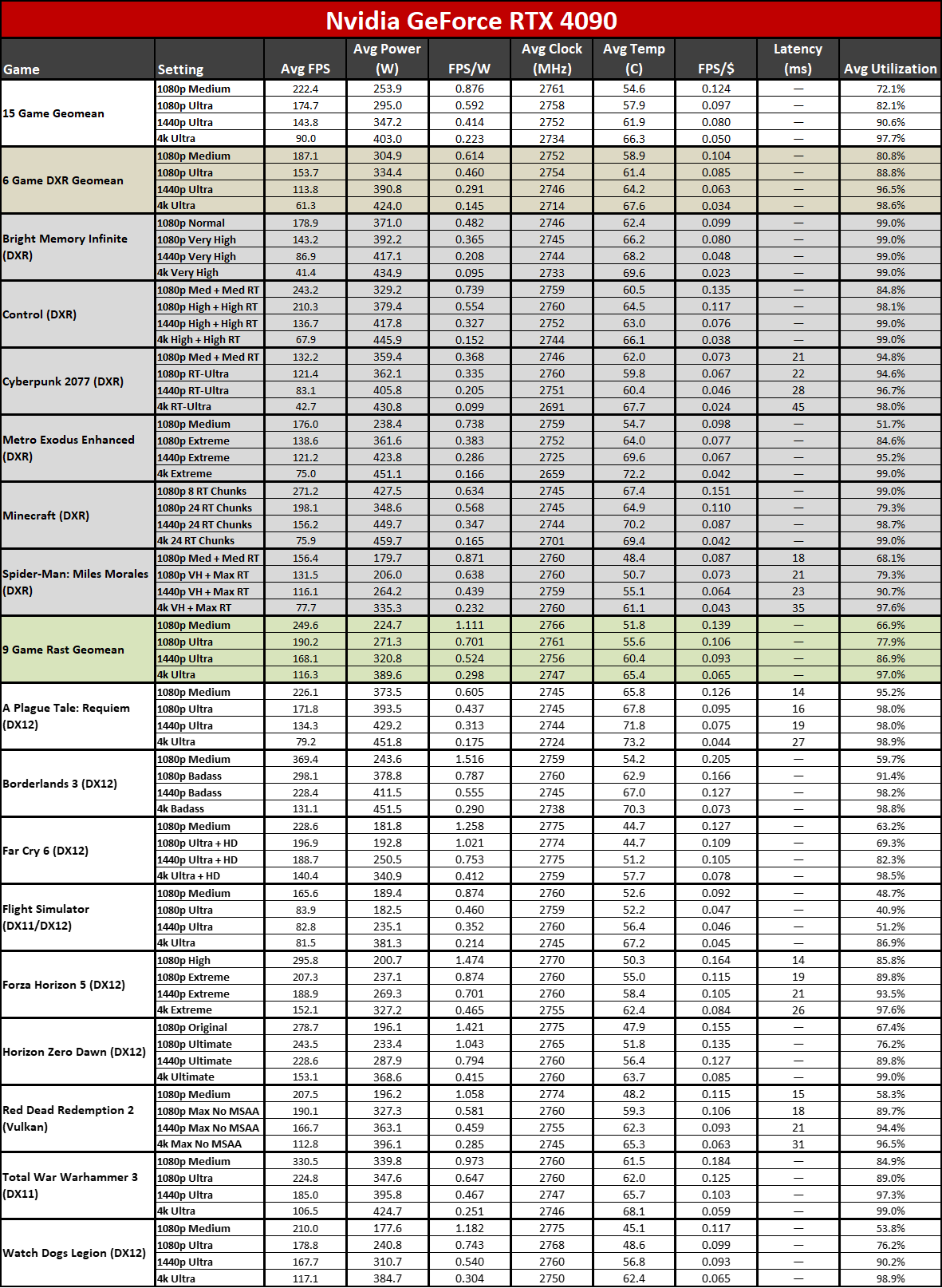
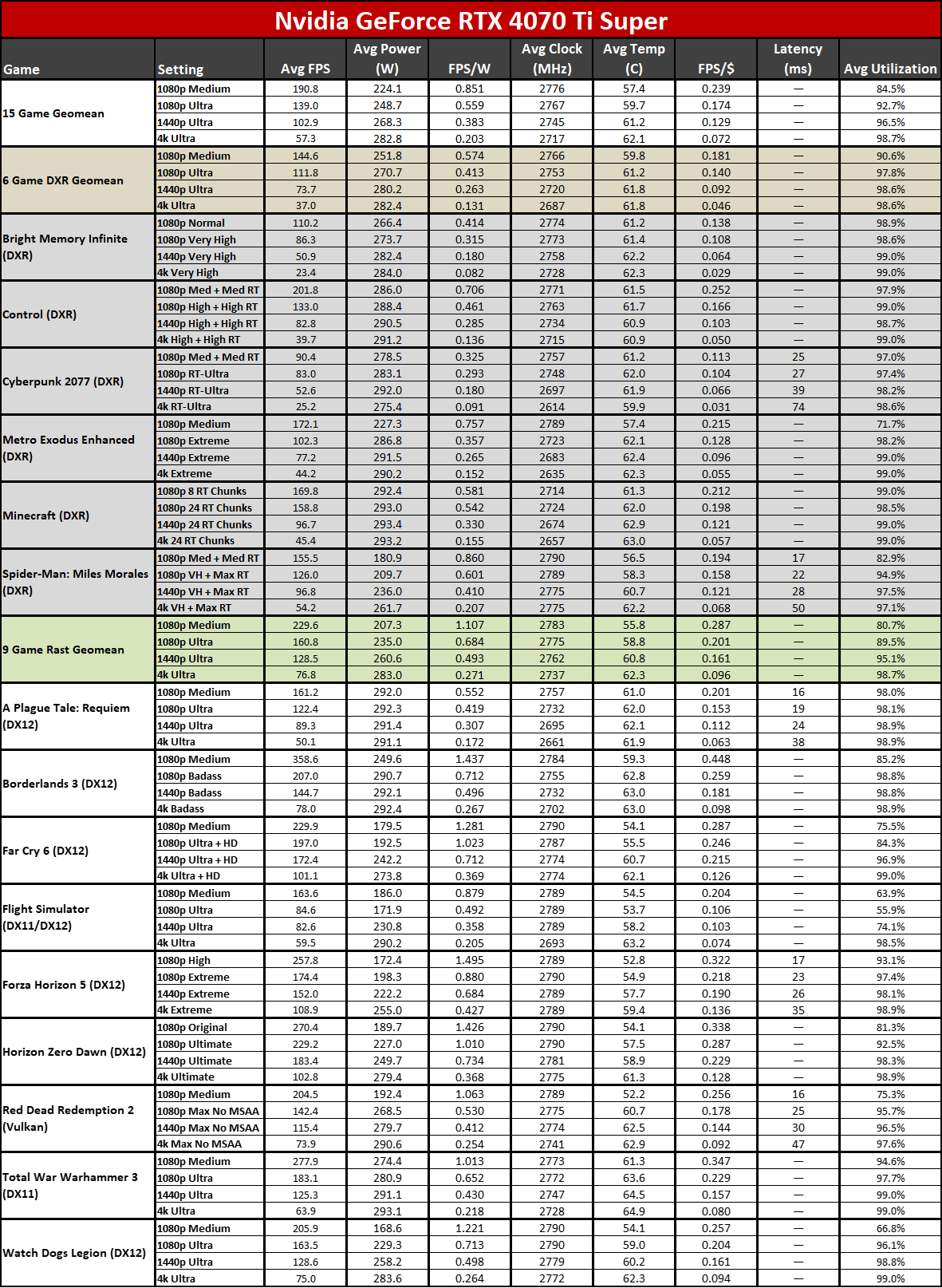
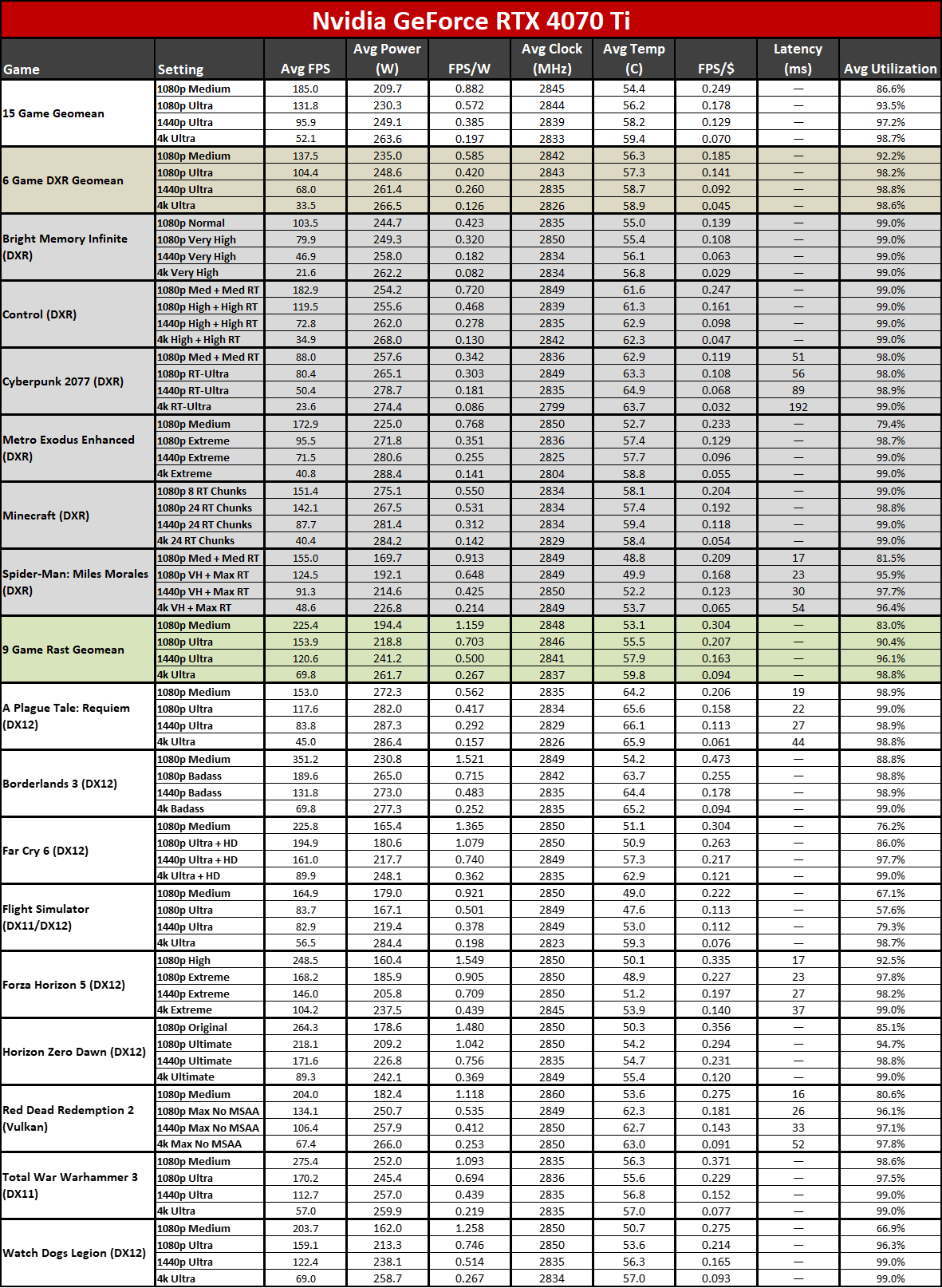
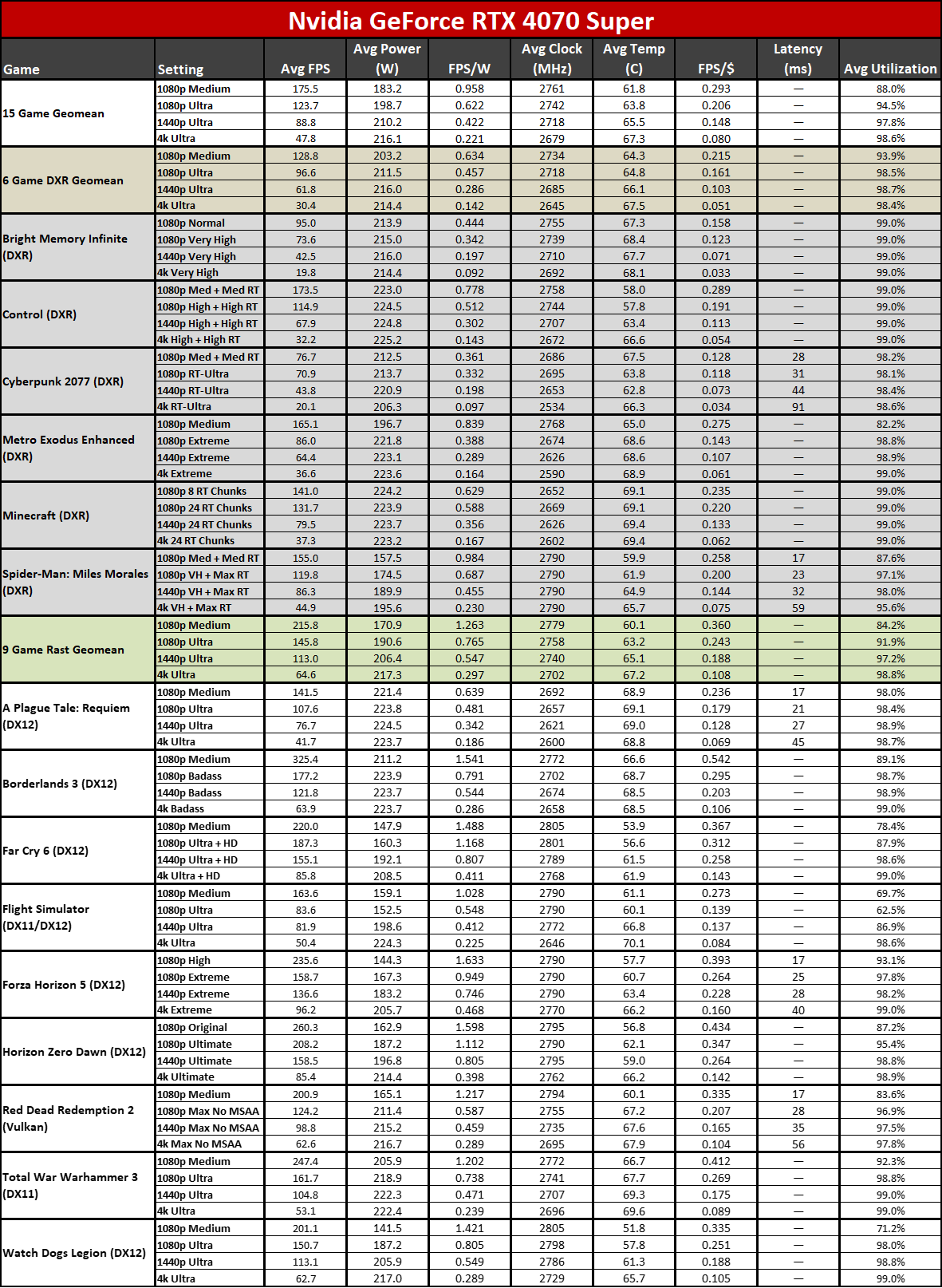

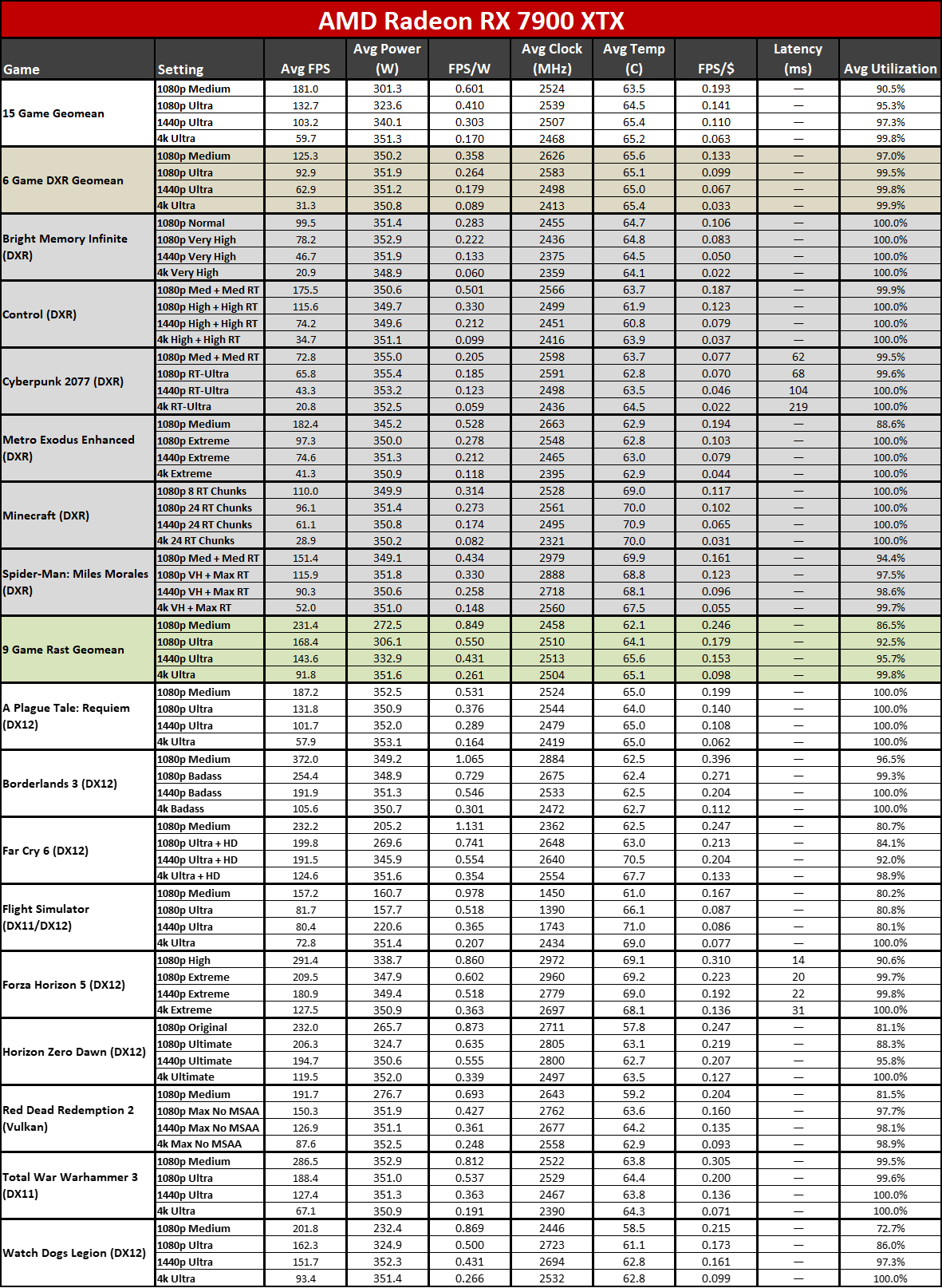
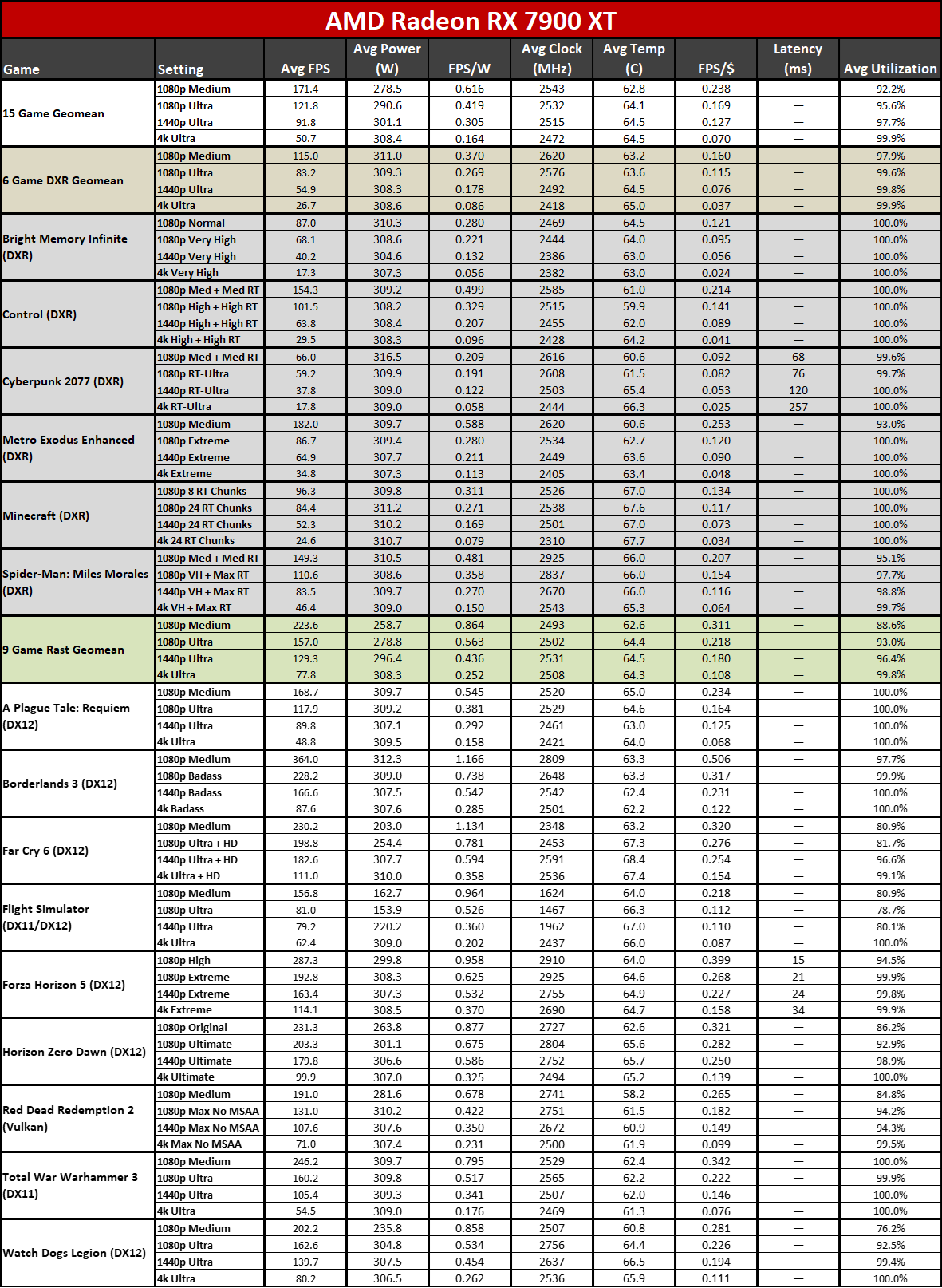
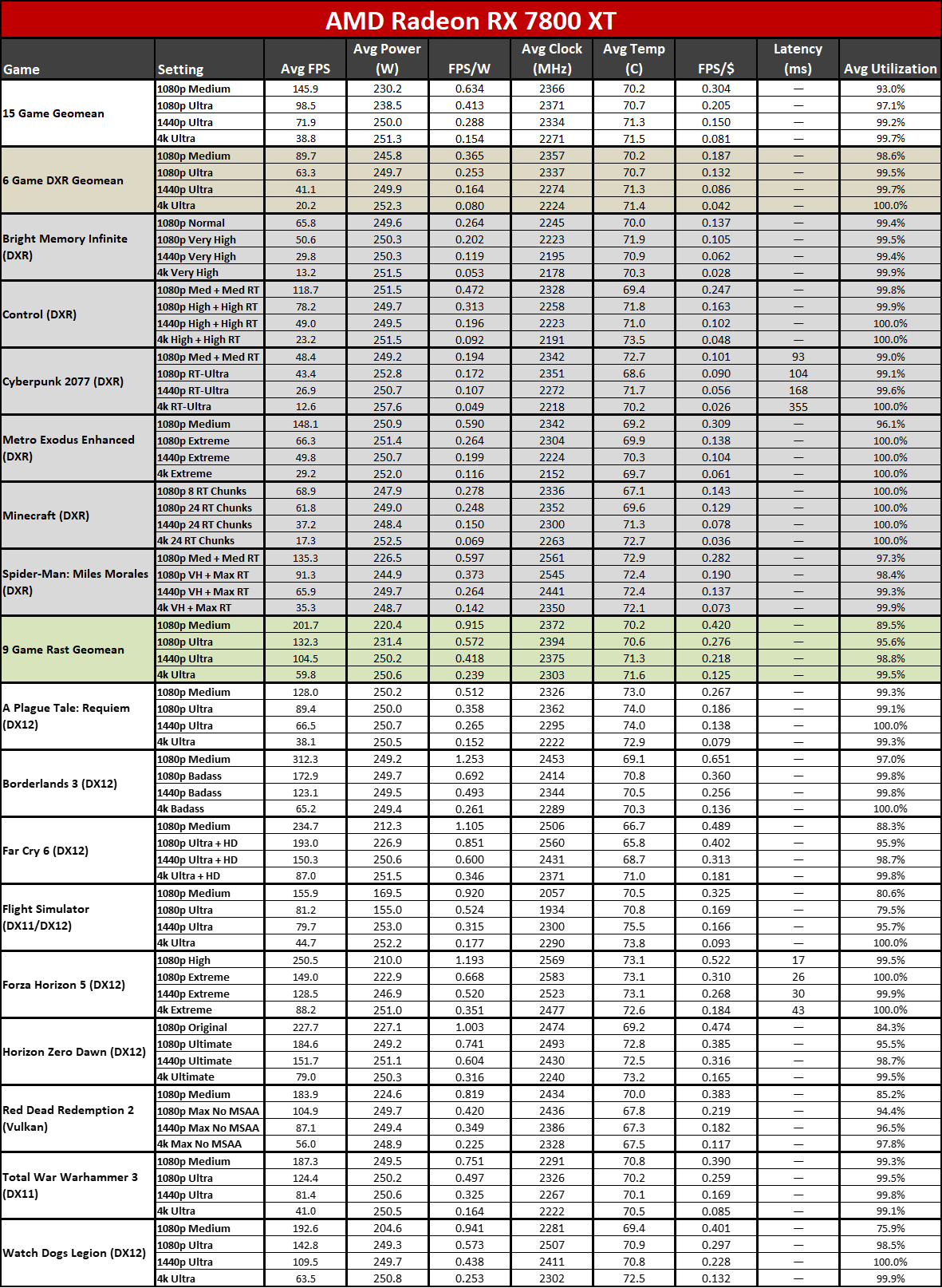
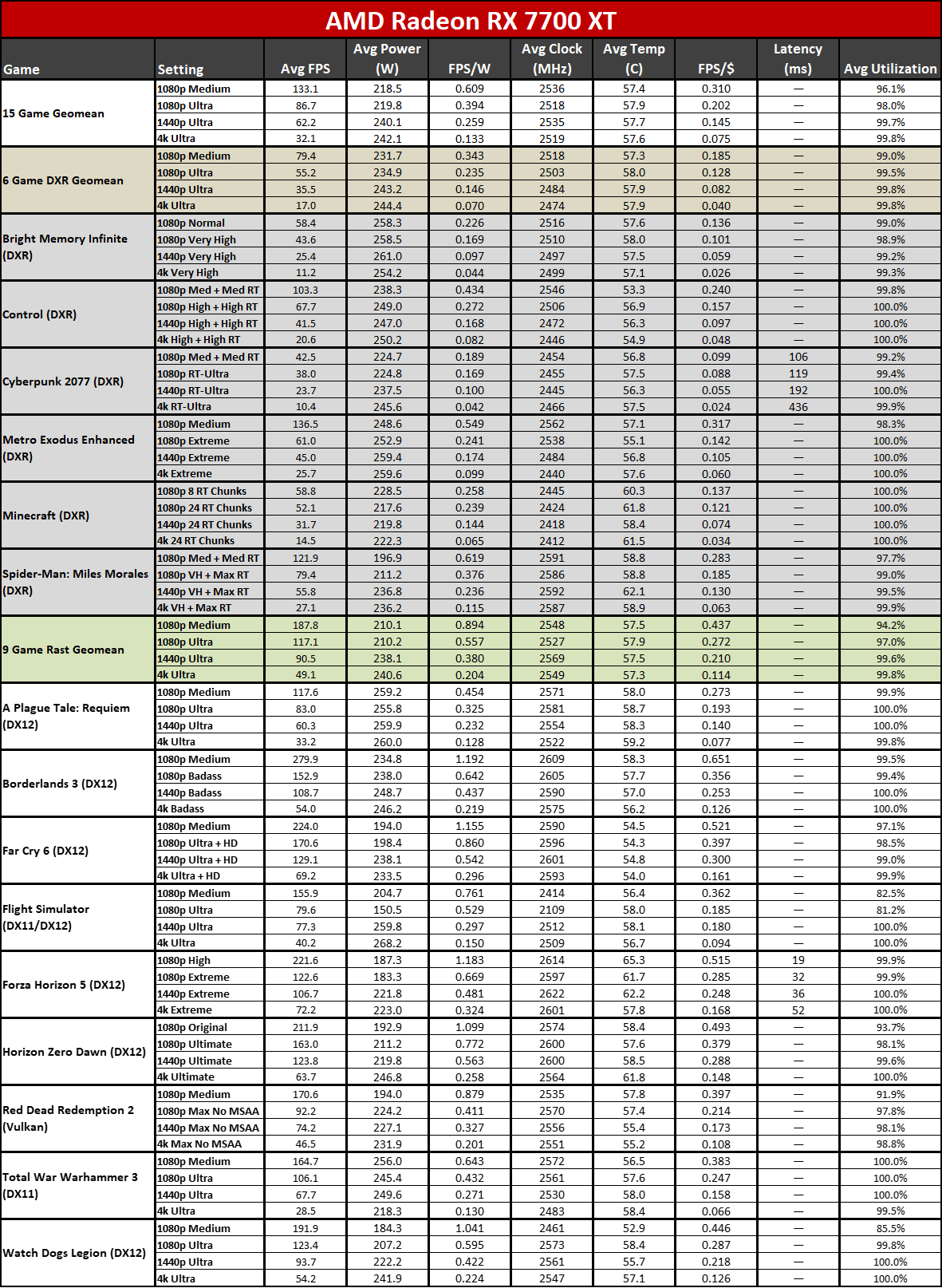
For those who like to look at the finer details, we've provided the above tables showing all of our gaming benchmarks, which include FPS/$ and FPS/W metrics. We use the best prices we can find at the time of writing, and MSRP for the newest cards like the 4080 Super. We won't dig into the details too much, but it's clear that Nvidia's Ada Lovelace GPUs lead all contenders when it comes to efficiency metrics, while the value proposition is murkier.
Looking at the cost of each GPU and its measured performance, the RTX 4080 Super lands ahead of the 4090 and the outgoing 4080, for obvious reasons. It's also ahead of the RX 7900 XTX but behind the 7900 XT, with AMD's best value being the 7800 XT (at least, when looking at the cards in this roundup). Nvidia's overall best value is the 4070 Super, followed closely by the vanilla 4070, with the 4070 Ti Super and 4070 Ti basically tied.
That pretty much matches our impression of the various GPUs. Raw performance stops scaling linearly with price past a certain point, and the 4080 Super passes that threshold, along with the 7900 XTX. Real-world pricing can and will change over time, so it will be interesting to see how things shake out in the coming months. The 4080 Super isn't a terrible value, but for most people, the 4070 Ti Super comes close enough in features and performance that it will be the better option.
- MORE: Best Graphics Cards
- MORE: GPU Benchmarks and Hierarchy
- MORE: All Graphics Content
Get Tom's Hardware's best news and in-depth reviews, straight to your inbox.
Current page: Nvidia RTX 4080 Super: Power, Clocks, Temps, and Noise
Prev Page Nvidia RTX 4080 Super: Professional Content Creation and AI Performance Next Page Nvidia RTX 4080 Super: Clearly cheaper, not much faster
Jarred Walton is a senior editor at Tom's Hardware focusing on everything GPU. He has been working as a tech journalist since 2004, writing for AnandTech, Maximum PC, and PC Gamer. From the first S3 Virge '3D decelerators' to today's GPUs, Jarred keeps up with all the latest graphics trends and is the one to ask about game performance.
-
Lamarr the Strelok $1000 for 16 GB VRAM. What a ripoff. Personally the 7600 XT with 16 GB VRAM is the only GPU I'd consider.Nvidia has better performance but their greed is incredible.Reply
I'll be using my 8 GB RX 570 til it's wheels fall off. Then I may simply be done with PC gaming. It's becoming ridiculous now. -
usertests Reply
I'm not going to tell you to continue PC gaming but there are plenty of options that are good enough for whatever you're doing, like an RX 6600. If you want more VRAM, grab a 6700 XT instead of 7600 XT, or an RTX 3060, while supplies last. Then if we later see the RX 7600 8GB migrate down to $200, and 7700 XT 12GB down to $350, those will be perfectly fine cards.Lamarr the Strelok said:$1000 for 16 GB VRAM. What a ripoff. Personally the 7600 XT with 16 GB VRAM is the only GPU I'd consider.Nvidia has better performance but their greed is incredible.
I'll be using my 8 GB RX 570 til it's wheels fall off. Then I may simply be done with PC gaming. It's becoming ridiculous now.
By the time you're done hodling your RX 570, the 7600 XT should be under $300 and at least RDNA4 and Blackwell GPUs will be out. -
RandomWan ReplyLamarr the Strelok said:$1000 for 16 GB VRAM. What a ripoff. Personally the 7600 XT with 16 GB VRAM is the only GPU I'd consider.Nvidia has better performance but their greed is incredible.
I'll be using my 8 GB RX 570 til it's wheels fall off. Then I may simply be done with PC gaming. It's becoming ridiculous now.
You're complaining about the VRAM (which doesn't matter as much as you think) and the price when you're sporting a bottom budget card. There's any number of cards you could upgrade to with a $300 budget that will blow that 570 out of the water.
These should be over 2x the performance of your card with 16GB for $330:
https://pcpartpicker.com/product/vT9wrH/xfx-speedster-swft-210-radeon-rx-7600-xt-16-gb-video-card-rx-76tswftfp
https://pcpartpicker.com/product/sqyH99/gigabyte-gaming-oc-radeon-rx-7600-xt-16-gb-video-card-gv-r76xtgaming-oc-16gd -
Gururu I thought healthy competition between companies meant the customer wins. This proves not the case. They do just enough to edge the competition when they could do soooo much more for the customer.Reply -
TerryLaze Reply
Being cheaper is not a bad thing, it's not contradictory to the first thing being good ( the slightly faster) it's not but cheaper, it's but also or and(also) cheaper.Admin said:Nvidia GeForce RTX 4080 Super review: Slightly faster than the 4080, but $200 cheaper : Read more -
InvalidError Reply
If nobody complains about ludicrously expensive GPUs having a bunch of corners cut off everywhere to pinch a few dollars on manufacturing off a $1000 luxury product, that is only an invitation to do even worse next time. No GPU over $250 should have less than 12GB of VRAM, which makes 16GB at $1000 look pathetic.RandomWan said:You're complaining about the VRAM (which doesn't matter as much as you think) and the price when you're sporting a bottom budget card.
Also, having 12+GB does matter as higher resolution textures are usually the most obvious image quality improvement with little to no impact on frame rate as long as you have sufficient VRAM to spare and 8GB is starting to cause lots of visible LoD asset pops in modern titles.
Corporations' highest priority customers are the shareholders and shareholders want infinite 40% YoY growth with the least benefits possible to the retail end-users as giving end-users too much value for their money would mean hitting the end of the road for what can be cost-effectively delivered that much sooner and be able to milk customers for that many fewer product cycles.Gururu said:I thought healthy competition between companies meant the customer wins. This proves not the case. They do just enough to edge the competition when they could do soooo much more for the customer. -
TerryLaze Reply
The last time we had healthy competition in anything computer related was in the 90ies.Gururu said:I thought healthy competition between companies meant the customer wins. This proves not the case. They do just enough to edge the competition when they could do soooo much more for the customer.
AMD buying ATI in 2006 was the last of any "healthy" competition, every other GPU company at that point was already defeated, also every other CPU company other that intel and AMD with ARM, as a company, barely hanging on even though ARM as CPUs are almost everywhere. -
magbarn As long as Nvidia makes a killing on AI, they're going to reserve the fat chips like the 4090 only for the highest priced products. They're allocating most of the large chips to AI, hence why the 4090 at MSRP sold out in minutes yesterday. This 4080 Super really is what the 4070 Ti should've been.Reply -
RandomWan ReplyInvalidError said:If nobody complains about ludicrously expensive GPUs having a bunch of corners cut off everywhere to pinch a few dollars on manufacturing off a $1000 luxury product, that is only an invitation to do even worse next time. No GPU over $250 should have less than 12GB of VRAM, which makes 16GB at $1000 look pathetic.
It carries a bit less weight complaing about it when you're rocking what was a sub $200 video card. There's things other than a reasonable price keeping you from the card. By all means complain where appropriate, but unless people stop buying it, your complaints will acheive nothing.
I don't know why you think a budget card should have that much RAM. You're not going to be gaming at resolutions where you can make use of those larger textures. I have a 1080Ti with 11GB (from the same timeframe) and the memory buffer isn't getting maxxed out at 3440x1440. Unless you're actually gaming at 4k or greater resolution, you're likely not running into a VRAM limitation, especially if you're making use of upscaling technologies. -
Lamarr the Strelok Well shadow of tomb raider at 1080p gets close to using 8 GB of VRAM. Far Cry 6 at 1440 uses close to 8 also.Reply
I admit I'm a budget gamer.(I have guitars and guitar amps to feed).But yes, UE 5 is a bit of a pig.Many UE5 games have an rx570,580, 590 as the minimum so the party's over for me soon.

